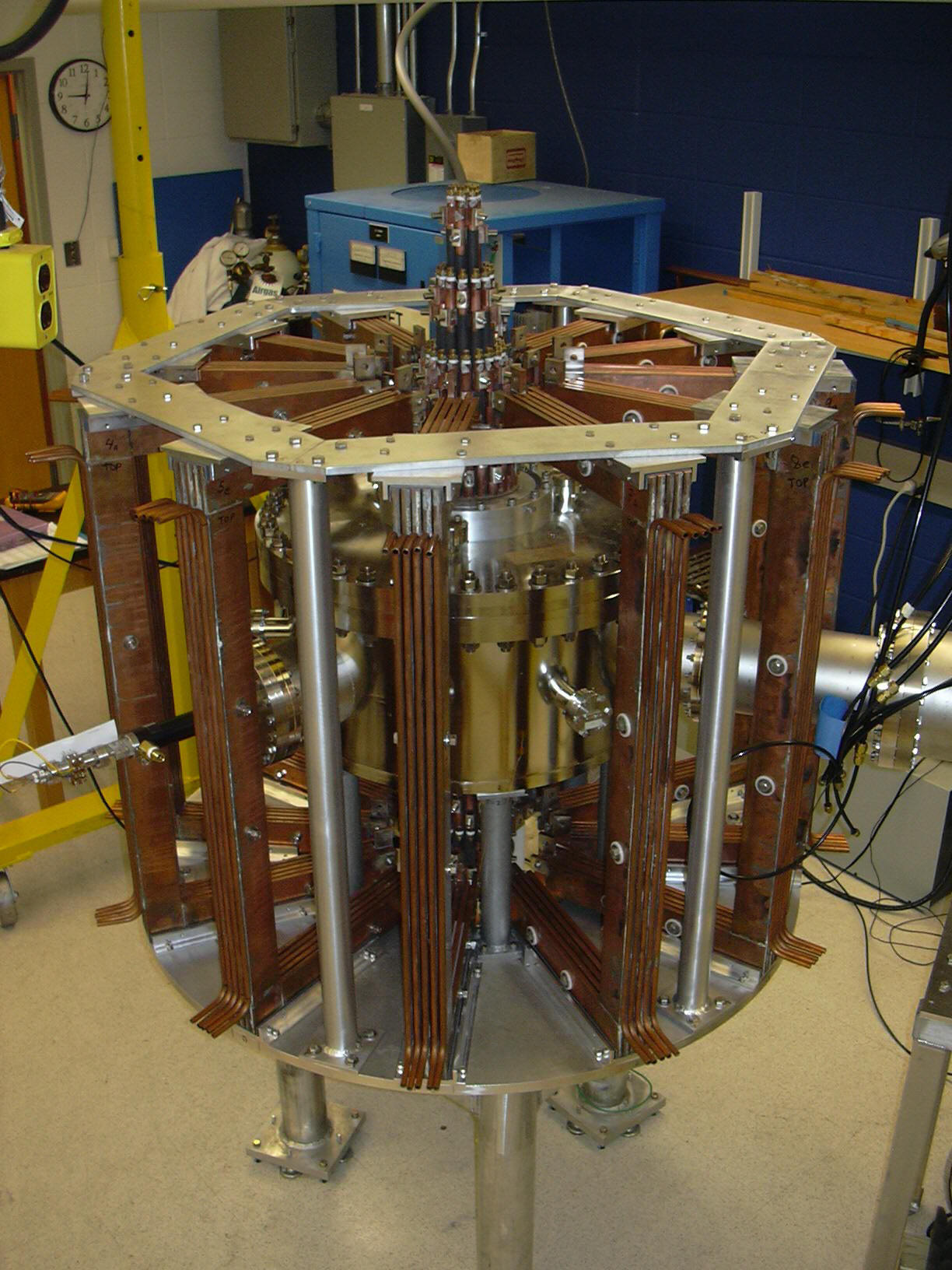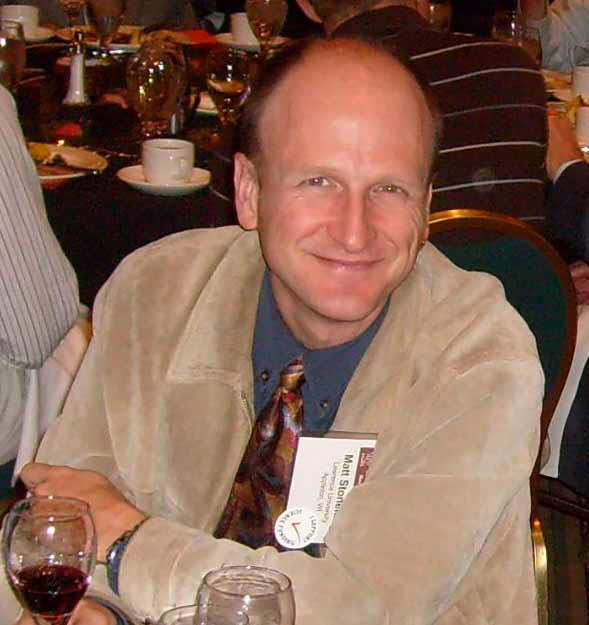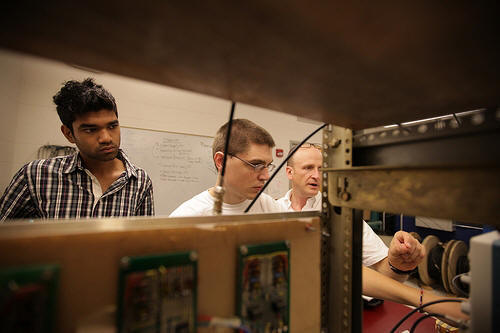Matthew R. Stoneking
Research Interests

Lawrence Non-Neutral Torus II
Plasma Physics
Plasma physics is the study of hot, ionized gases, sometimes referred to as the fourth state of matter. A plasma, being a collection of charged particles interacting with each other over long distances via electric and magnetic forces, exhibits a wide array of complex behavior including waves and instabilities. Plasmas occur abundantly in space (stars, the solar wind and the interstellar medium) and in the earth's ionosphere (evidenced by, for example, auroral activity). [Plasma Physics links]
One of the potential applications of plasma physics is the production of
electric power from nuclear fusion. To release significant power from fusion
reactions requires that the fuel be 1) hot, 2) dense, and 3) well contained.
The most promising method for containing (or confining) a hot plasma is magnetic
confinement whereby a strong magnetic field insulates the plasma from the
walls of the container. Perfect insulation is not generally achieved because turbulent
fluctuations arise in the plasma that transport
plasma particles and energy out of the magnetic field and into the wall of the
container. A major emphasis of my graduate and post-doctoral research was
dedicated to quantifying the turbulent transport due to magnetic turbulence, to
understanding the physics governing the turbulence and attempting to reduce the
turbulence, i.e. plugging the leaks in the magnetic bottle. Since coming to
![]()
Toroidal
Pure Electron Plasmas
Non-neutral plasmas are collections of charged particles of a single sign of charge. The most commonly studied non-neutral plasmas are pure electron plasmas and (positive) ion plasmas, although other exotic examples such as positron (i.e. anti-electron) plasmas or negative ion plasmas are also possible. Non-neutral plasmas exhibit many of the same phenomena as traditional, more commonly studied plasmas that contain nearly equal quantities of positive and negative charge. Collective (or many-body) effects such as the screening out of electric potential perturbations, the propagation of particle density waves, and the growth of unstable perturbations are characteristic features of both traditional and non-neutral plasmas. However, since non-neutral plasmas are charged, they possess a self-electric field or “space-charge electric field.” The space charge electric field of the non-neutral plasma introduces behavior that is peculiar to such systems. In my experiment, I exploit one such peculiar feature of non-neutral plasmas, namely plasma flow or rotation, to confine it.
The Lawrence Non-neutral Torus II (LNT II) experiment and its predecessor, the LNT, continue a sparse but historically extended line of experiments in which electron plasmas are confined in a purely toroidal magnetic field. In 2004 we demonstrated (in LNT) that electron plasmas could be trapped for more than 10 milliseconds in a purely toroidal magnetic field. This was the first unambiguous demonstration that the self-electric field (space-charge electric field) of the plasma and its associated plasma flow can act to like the poloidal magnetic field of a tokamak to provide and effective rotational transform. Without this effect, the plasma would drift out of the trap on the timescale of about 100 microseconds. Confinement was ultimately limited by either diffusion associated with collisions with neutral gas atoms or transport associated with asymmetries in the trap. In 2008 we achieved (in LNT II) a confinement time in excess of one second, demonstrating the first nearly-steady state for toroidal electron plasmas.
![]()
Papers from the Lawrence Non-neutral Plasma Physics Group:
![]() M.R.
Stoneking, J.P.
Marler, B.N. Ha, and J.
Smoniewski, Experimental realization of nearly steady-state
toroidal electron plasmas, Phys. Plasmas 16,
055708 (2009).
M.R.
Stoneking, J.P.
Marler, B.N. Ha, and J.
Smoniewski, Experimental realization of nearly steady-state
toroidal electron plasmas, Phys. Plasmas 16,
055708 (2009).
![]() B.N. Ha, M.R. Stoneking, and J.P. Marler,
Using numerical simulations to extract parameters of
toroidal electron plasmas from experimental data,
Phys. Plasmas 16, 032110 (2009).
B.N. Ha, M.R. Stoneking, and J.P. Marler,
Using numerical simulations to extract parameters of
toroidal electron plasmas from experimental data,
Phys. Plasmas 16, 032110 (2009).
![]() J.P.
Marler, J. Smoniewski,
Bao Ha, and M.R.
Stoneking, “Achieving Long Confinement in a
Toroidal Electron Plasma,” in Non-neutral Plasma Physics VII, AIP
Conf. Proc. 1114, edited by J. Danielson, (American Institute of Physics, New
York, 2009), p.39, Workshop on Non-neutral Plasmas
J.P.
Marler, J. Smoniewski,
Bao Ha, and M.R.
Stoneking, “Achieving Long Confinement in a
Toroidal Electron Plasma,” in Non-neutral Plasma Physics VII, AIP
Conf. Proc. 1114, edited by J. Danielson, (American Institute of Physics, New
York, 2009), p.39, Workshop on Non-neutral Plasmas
![]() J.P. Marler and M.R. Stoneking, Confinement Time Exceeding One Second for a Toroidal Electron Plasma,
Phys. Rev.
Lett. 100, 155001 (2008).
J.P. Marler and M.R. Stoneking, Confinement Time Exceeding One Second for a Toroidal Electron Plasma,
Phys. Rev.
Lett. 100, 155001 (2008).
![]() J.P. Marler and M.R. Stoneking, Non-neutral
Plasma Confinement in Toroidal Geometry, Journal
of Physics: Conference Series 71, 012003 (2007). Workshop on Nonequilibrium Processes in Plasma Physics and Studies of
the Environment.
J.P. Marler and M.R. Stoneking, Non-neutral
Plasma Confinement in Toroidal Geometry, Journal
of Physics: Conference Series 71, 012003 (2007). Workshop on Nonequilibrium Processes in Plasma Physics and Studies of
the Environment.
![]() J.P. Marler and M.R. Stoneking, A
Kilogauss-scale, High-vacuum Toroidal Electron Plasma
Experiment, in Non-neutral
Plasma Physics VI, AIP Conf. Proc. 862, edited by M. Drewsen, U. Uggerhoj, and H.
Knudsen, (American Institute of Physics, New York, 2006), p. 71. Workshop
on Non-neutral Plasmas.
J.P. Marler and M.R. Stoneking, A
Kilogauss-scale, High-vacuum Toroidal Electron Plasma
Experiment, in Non-neutral
Plasma Physics VI, AIP Conf. Proc. 862, edited by M. Drewsen, U. Uggerhoj, and H.
Knudsen, (American Institute of Physics, New York, 2006), p. 71. Workshop
on Non-neutral Plasmas.
![]() M. R. Stoneking, M. A. Growdon, M.L.
Milne, and R. T. Peterson, Poloidal ExB drift used as an effective rotational transform to
achieve long confinement times in a toroidal electron
plasma, Phys. Rev. Lett. 92, 095003
(2004).
M. R. Stoneking, M. A. Growdon, M.L.
Milne, and R. T. Peterson, Poloidal ExB drift used as an effective rotational transform to
achieve long confinement times in a toroidal electron
plasma, Phys. Rev. Lett. 92, 095003
(2004).
![]() M.R. Stoneking, M.A. Growdon, M.L.
Milne, and R.T. Peterson, Millisecond Confinement and Observation of the
m=1Diocotron Mode in a Toroidal Electron Plasma,
in Non-neutral Plasma Physics V, AIP Conf. Proc. Vol. 692, edited by M. Schauer, T. Mitchell, and R. Nebel,
2003.
M.R. Stoneking, M.A. Growdon, M.L.
Milne, and R.T. Peterson, Millisecond Confinement and Observation of the
m=1Diocotron Mode in a Toroidal Electron Plasma,
in Non-neutral Plasma Physics V, AIP Conf. Proc. Vol. 692, edited by M. Schauer, T. Mitchell, and R. Nebel,
2003.
![]() M.R. Stoneking, P.W. Fontana, R.L. Sampson, and D.J. Thuecks, Electron plasmas in a "partial" torus,
Phys. Plasmas 9, (2002).
M.R. Stoneking, P.W. Fontana, R.L. Sampson, and D.J. Thuecks, Electron plasmas in a "partial" torus,
Phys. Plasmas 9, (2002).
![]() M.R. Stoneking, P.W. Fontana, R.L. Sampson, and D.J. Thuecks, Electron Plasma Confinement in a Partially Toroidal Trap, in Non-neutral Plasma Physics IV,
AIP Conf.Proc. Vol. 606, edited by F. Anderegg, L. Schweikhard and C.F.
Driscoll, 2001
M.R. Stoneking, P.W. Fontana, R.L. Sampson, and D.J. Thuecks, Electron Plasma Confinement in a Partially Toroidal Trap, in Non-neutral Plasma Physics IV,
AIP Conf.Proc. Vol. 606, edited by F. Anderegg, L. Schweikhard and C.F.
Driscoll, 2001
![]()
Current Members of the Lawrence Plasma Physics Group
Dr. Matthew Stoneking, Professor of Physics
Faraz Choudhury, Lawrence Class of 2011
Andrew Knoedler, Lawrence Class of 2011

![]()
Former Members of the Lawrence Plasma Physics Group
Eric Frater, Lawrence Class of 2011
Jason Smoniewski, Lawrence Class of 2009
Dr. Joan Marler, Lawrence Fellow
in Physics 2005-2007
Sarah Curry, Lawrence Class of 2008
Julian Hector, Lawrence Class of 2008
Bao Ha, Lawrence Class of 2007
Duncan Ryan, Lawrence Class of 2006

Michelle Milne, Lawrence Class of 2004
Mark Growdon, Lawrence Class of 2004
Ryan 'Ace' Peterson, Lawrence Class of 2003
Dr. Paul Fontana, Visiting Assistant Professor of Physics 2001-2003
Robin Sampson, Lawrence Class of 2002, M.S. Cornell University
Derek Thuecks, Lawrence Class of 2002, Ph.D. University of Iowa
Angela Kopp, Lawrence Class of 2001, Ph.D. University of California Los Angeles
Kurt Taylor, Lawrence Class of 1999, Ph.D. University of California San Diego
Erik Brubaker, Lawrence Class of 1999, Ph.D. University of California Berkeley
Mark Nornberg, Lawrence Class of 1998, Ph.D. Univ. of Wisconsin - Madison
![]()
Photographs of the Lawrence Non-neutral Torus II.


 .
. 